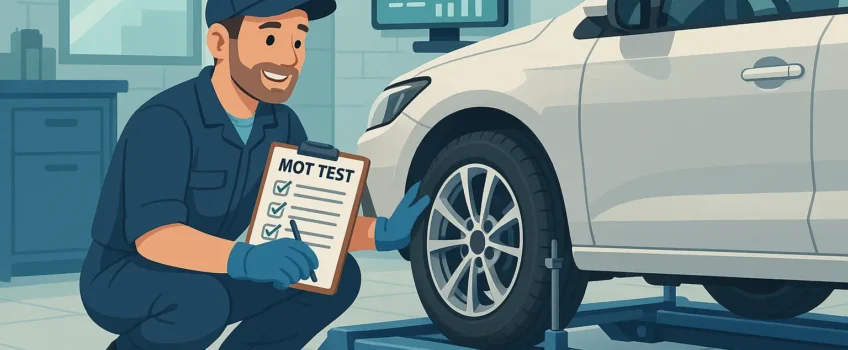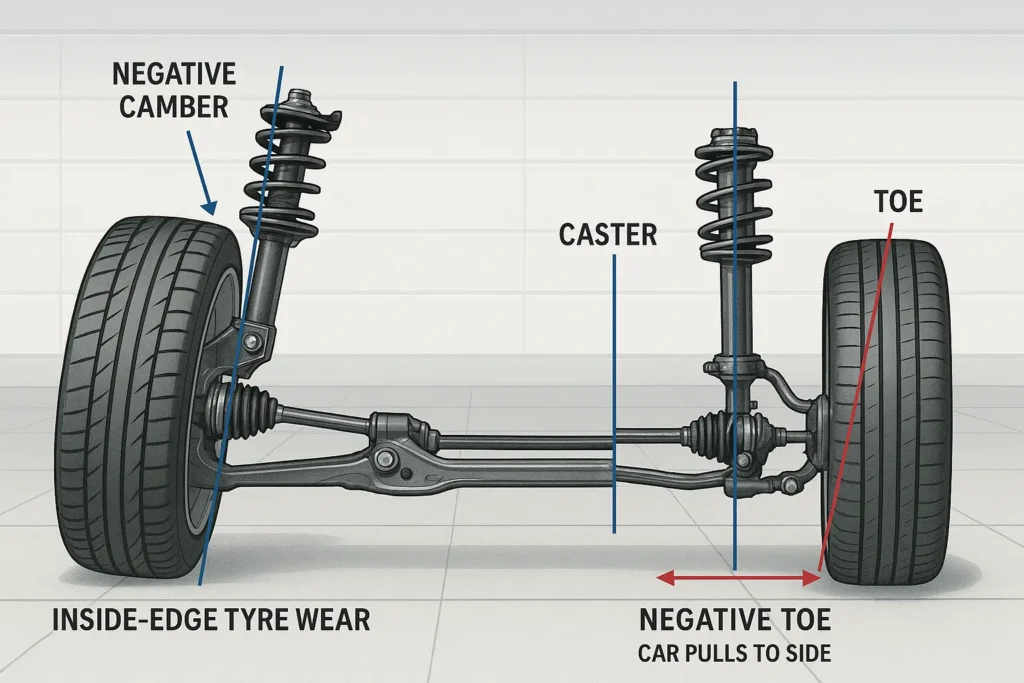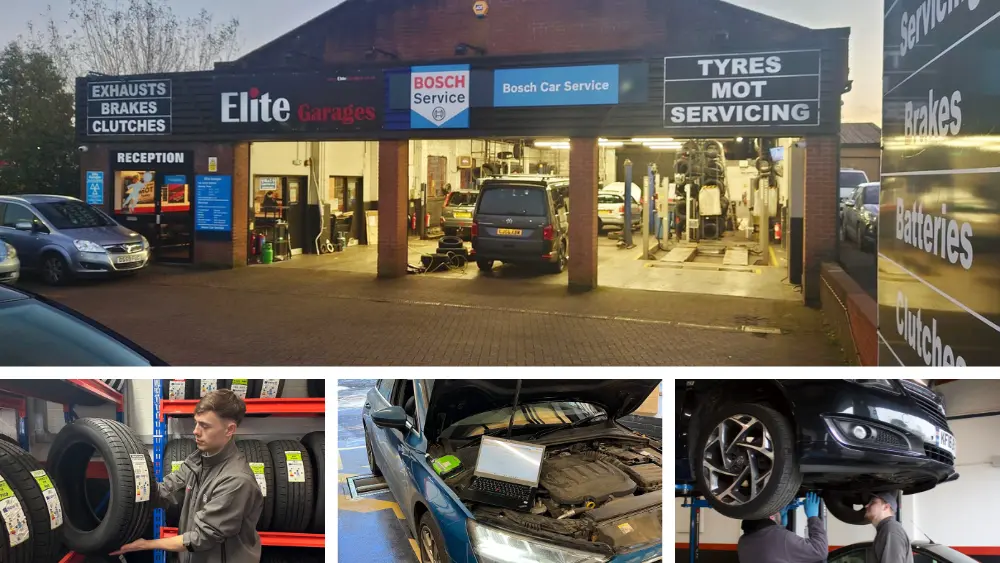
Your Guide to Car MOT Tests: Avoid Common Pitfalls and Fails
For many UK drivers, the term “MOT” evokes equal parts duty and dread. Yet car MOT tests are a crucial component of keeping roads safe, ensuring each vehicle meets the minimum legal standards for roadworthiness and emissions. This comprehensive guide is designed to demystify MOT requirements, highlight how areas like wheel alignment, and car tyres influence your test results. We also outline the essential car services available at Elite Garages and how you can receive free MOT and service reminders!
Whether you’re an experienced driver or new to the whole MOT process, understanding the ins and outs of car MOT tests can save you time, money, and unnecessary stress. By proactively addressing key aspects of your car’s health, you’ll pass the MOT first time without any issues and maintain confidence on the road year-round.
1. Understanding Car MOT Tests
Car MOT tests are named after the now-defunct Ministry of Transport, but the essential purpose remains the same: to certify that vehicles on UK roads meet the minimum standards of safety and environmental responsibility. Once your car is three years old, the annual MOT becomes a legal requirement. Driving without a valid certificate can result in significant fines, penalty points, or even legal action.
What is Checked During an MOT?
During an MOT, a certified inspector will check vital components of your vehicle, including:
- Lights, Signals, and Electrical Components: Ensuring headlights, indicators, and brake lights function correctly.
- Brakes and Steering: Verifying the braking system meets stopping-distance regulations and that steering is precise.
- Suspension: Checking for worn or damaged parts that could compromise handling.
- Emissions and Exhaust System: Testing for excessive pollutants and leaks.
- Car Tyres: Verifying correct tread depth, suitable tyre type, and no signs of dangerous wear or bulges.
- Seatbelts and Safety Restraints: Confirming they operate properly and are in good condition.
- General Bodywork: Identifying any issues that might interfere with safe operation (e.g., sharp edges, structural rust).
If your car passes, you receive a certificate valid for 12 months. If it fails, you’ll be provided with a list of necessary repairs or advisories, indicating what must be fixed before a retest can be completed.
Why Car MOT Tests Are Important
- Legal Compliance: It’s against the law to drive a car over three years old without a valid MOT certificate (unless you’re driving it to a pre-booked MOT appointment).
- Road Safety: Regular testing ensures you and other road users remain protected from mechanical failures that could otherwise contribute to accidents.
- Environmental Standards: The MOT checks emissions, ensuring vehicles produce acceptable levels of harmful gases.
- Cost Savings: By identifying minor faults early, you can avoid more extensive and expensive repairs down the line.
Driving without a valid MOT certificate isn’t just illegal—it can also significantly reduce your vehicle’s value. This is an important factor to consider when buying or selling a car.
2. How Wheel Alignment and Wheel Tracking Affect Car MOT Tests

Often used interchangeably, wheel alignment or wheel tracking refers to adjusting the angles of your wheels so they conform to the manufacturer’s specified angles. Proper alignment is fundamental to the safe and efficient operation of your vehicle—and it can make or break your MOT outcome.
Wheel Alignment Basics
Wheel alignment encompasses three primary angles: camber, caster, and toe. If any of these angles deviate from the guidelines set by your car’s manufacturer, you risk uneven tyre wear and altered handling. For instance, a negative toe angle could make your car pull to one side, while excessive camber wear would be evident on the inside edge of your tyres.
During car MOT tests, inspectors examine tyre wear patterns, steering response, and your suspension. Misaligned wheels can cause premature tyre wear, poor steering control, and added strain on suspension parts, increasing the risk of failure and safety issues. These issues may result in an MOT fail or advisories that must be addressed before a pass is granted. Regular checks and alignments ensure you’ll avoid unwelcome surprises.
Benefits of Correct Wheel Alignment
- Extended tyre life: Even tread wear equals fewer costly tyre replacements.
- Improved fuel efficiency: Reduced rolling resistance helps your engine perform more economically.
- Better handling: A properly aligned car is more stable, especially at higher speeds.
- Safer on the road: Maximised tyre contact with the road surface means better overall control.
3. Why Car Tyres Matter for Your MOT
Of all the checks performed during car MOT tests, tyres are among the top reasons vehicles fail. Because tyres are your car’s only contact with the road, their condition is taken extremely seriously for both safety and regulatory reasons. Here are some basic but super important tyre requirements:
- Tread Depth: The legal minimum tread depth in the UK is 1.6mm across the central three-quarters of the tyre. Anything below that is an immediate fail.
- Tyre Condition: Cuts, bulges, or embedded objects can make tyres unsafe and increase the likelihood of immediate failure.
- Tyre Pressure: Although exact pressure isn’t typically measured during an MOT, visibly underinflated tyres or those clearly mismatched may prompt closer inspection.
- Tyre Specifications: Using the correct tyre type (e.g., load rating) for your vehicle is absolutely vital.
Unsure of your MOT due date? Simply enter your registration number here to check.
The Role of Wheel Tracking in Tyre Health
As mentioned earlier, incorrect wheel alignment leads to uneven and accelerated tyre wear. Even if your tread depth seems acceptable in one spot, it could be drastically lower on another portion of the tyre. MOT inspectors examine tyres as a whole, and if any area is below the legal threshold or exhibiting dangerous wear patterns, your MOT certificate is at risk. Book your wheel alignment at Elite Garages today!
4. Common MOT Failures and How to Avoid Them
Aside from wheel alignment, there are other factors that can cause your vehicle to fail its MOT. Here are some common MOT failures and how you can avoid them:
- Insufficient Tyre Tread / Damaged Tyres: The simplest prevention is regular tread checks and quick responses to any signs of damage.
- Faulty Lights / Indicators: A quick pre-MOT check, testing your headlights, taillights, and indicators, can avoid an easy fail.
- Worn Brakes: Grinding noises or reduced responsiveness under braking usually signal worn pads or discs. Address these immediately.
- Steering and Suspension Issues: Unusual clunking sounds or excessive bouncing over bumps are red flags.
- Excessive Emissions: Regular servicing helps keep your engine running efficiently. Clean oil and properly functioning filters help reduce harmful output.
5. Preparing for Car MOT Tests: Practical Tips
- Do a Basic Inspection: Check lights, tyre condition, fluid levels, and wipers. Many of these are quick fixes if issues are found.
- Top Up Engine Oil and Coolant: Low fluid levels aren’t direct fails, but mechanics may note poor upkeep.
- Clean Your Vehicle: A car interior or exterior filled with clutter might make the inspector’s job harder. Some MOT centres can refuse to test excessively dirty cars.
- Listen for Strange Noises: A squeak, rattle, or knocking could be a hint of suspension or brake troubles.
- Schedule Routine Maintenance in Advance: Don’t wait until a week before your MOT. Minor repairs could turn into major ones if left too long.
6. What to Expect During Car MOT Tests
- An MOT usually takes between 45 minutes and an hour, though additional time may be required if repairs are necessary.
- In the testing bay, the inspector uses a combination of visual checks, physical assessments, and diagnostic equipment.
- Your car is hooked up to an emissions tester to ensure compliance with pollution limits.
- The car technician or mechanic tests your brakes under different load conditions.
- Each bulb is checked to confirm proper operation.
You’ll either get a pass certificate or a failure document outlining necessary repairs after the MOT. Advisories note minor issues to address soon, while failure codes highlight serious defects that must be fixed for a pass.
| Defect Category | Item Description | MOT Result |
|---|---|---|
| Dangerous | A defect that has a direct and immediate risk to road safety or presents a serious impact on the environment. Do not drive the vehicle until it has been repaired. | Fail |
| Major | Possible effect on vehicle safety and may put other road users at risk or have an impact on the environment. Repair the defect immediately. | Fail |
| Minor | No significant effect on the safety of the vehicle or impact on the environment. Repairs are required as soon as possible. | Pass |
| Advisory | Not a safety concern yet but could become more serious in the future. Monitor and repair if needed. | Pass |
| Pass | It meets the minimum legal standard. Ensure that it continues to meet the standard. | Pass |
Understanding these codes can improve communication with your mechanic and give you better insight into the required repairs. To learn more about MOT fault codes, refer to the official MOT guidance.
7. Post-MOT: Keeping Your Car Roadworthy
If your car passes, congratulations! You have 12 months before the next test. However, the best way to avoid stress next time is to continue prioritising maintenance. If the inspector gave advisories, address them sooner rather than later as this helps prevent sudden breakdowns and means you’re less likely to receive a fail in the future.
- Act on Advisories: Worn tyres, brake pads, or suspension components might last a while longer, but it’s safer (and often cheaper) to tackle them as soon as possible.
- Annual Service: Combining an annual service with car MOT tests streamlines the entire process, saving you from multiple garage visits.
- Track Your MOT Due Date: Mark it in your calendar or set a digital reminder. Driving without MOT coverage risks legal trouble and invalidates most insurance policies. Sign up for the Elite Member’s Club to receive free MOT email and text reminders!
8. Car Services at Elite Garages

One of the best ways to ensure you pass car MOT tests is to partner with a trusted service centre that understands how all your car’s components work together. At Elite Garages, we offer a comprehensive range of services designed to keep your vehicle roadworthy year-round. Whether you’re prepping for an MOT or simply maintaining your vehicle, our team is here to help.
Our comprehensive car services include cambelt replacement, battery testing and replacement, brake and clutch repairs, tyre services, ADAS calibration, exhaust repairs, advanced diagnostics, suspension checks, and air con repairs. We also offer free safety and tyre checks to ensure your car is safe, efficient, and ready for the road. For more details, check out Our Services on the website.
9. Booking Car MOT Tests at Elite Garages
Car MOT tests may be legally required, but they’re also an invaluable tool for monitoring your vehicle’s overall health and ensuring the safety of everyone on the road. By paying particular attention to aspects like wheel alignment, wheel tracking, and car tyres, you’ll greatly improve your chances of passing. Plus, taking advantage of Elite Garages’ online MOT bookings and comprehensive car services, including free safety checks and advanced diagnostics, can help simplify the process while saving time and money.
Ready to ensure your car is ready for its MOT? Book a free vehicle safety check at Elite Garages today and experience the difference of working with knowledgeable experts who are committed to your safety and satisfaction.
Where Can I Book Car MOT Tests Near Me?
- MOT Bournemouth
- MOT Brighton
- MOT Canterbury
- MOT Caterham
- MOT Deal
- MOT Eastbourne
- MOT Fareham
- MOT Haywards Heath
- MOT Horsham
- MOT Maidstone
- MOT Newport
- MOT Portsmouth
- MOT Pulborough
- MOT Salisbury
- MOT Shaftesbury
- MOT Southampton
FAQS: Car MOT Tests
Click the + to read any answer or visit our most FAQ page to review the most frequently asked questions across all our Elite Locations.`
If you click on a ‘Category’ or ‘Tag’ link, the page will ‘refresh’ and reload the page showing the top of the page first, you’ll then just need to scroll down to the FAQ section to see the results for the Category or Tag you selected.
An MOT is a legal requirement and driving without one could result in serious consequences, including a £1,000 fine (or up to £2,500), a driving ban and 3 penalty points on your licence if your MOT faults are deemed ‘dangerous’. Your vehicle insurance may also be invalidated.
About Us
Opening Times
Saturday : 8:30–4:00
Sunday : closed
More Information
Contact UsCustomer Information Pack
Check MOT Due Date
Free MOT reminder
Careers


